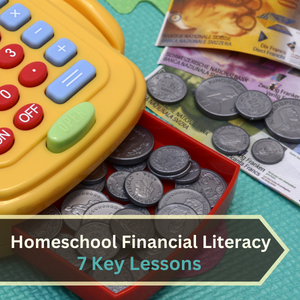Welcome to the dynamic world of homeschooling! If you’re a homeschool mom juggling the educational needs of multiple children, this article is crafted just for you. We delve into homeschooling at various ages, offering practical, proven strategies to make your homeschool journey effective and enjoyable. Whether you’re a seasoned homeschooler or new to the scene, these insights are invaluable for homeschooling multiple kids.
Trying to Homeschool Multiple?
Are you ready to discover the secret sauce that makes homeschooling multiple ages manageable and a joyful and rewarding experience? It’s about understanding that homeschooling is not a one-size-fits-all model. It’s a dynamic, adaptable, and incredibly personal journey for each family. The key ingredients? Flexibility, creativity, and a deep understanding of each child’s unique needs.
Imagine creating a learning environment where your children, despite their different ages, learn from and with each other. Your older child’s curiosity about science sparks a hands-on experiment that even your preschooler can participate in. Where a history lesson turns into a family reenactment of a historical event, making learning fun and memorable for everyone.
This is the beauty of homeschooling multiple ages – it allows for a fusion of ideas, learning styles, and experiences, creating a rich tapestry of education that is as unique as your family. By weaving together the individual strengths and interests of each child, you create a cohesive learning experience that is both inclusive and effective.
So, let’s delve into how you can master the art of homeschooling multiple children, turning potential challenges into opportunities for growth, learning, and family bonding. Remember, in homeschooling, your family’s unique journey is the most beautiful story to tell.
- Understanding Each Child’s Unique Needs
- Combining Subjects Across Ages
- Creating a Flexible Yet Structured Schedule
- Incorporating Independent and Group Learning
- Utilizing Online Resources and Community Support
- Designing Multi-level Curriculum
- Setting Realistic Goals and Expectations
- Balancing One-on-One Time with Each Child
- Adapting the Curriculum for Different Learning Styles
- Reflecting and Adjusting: The Key to Homeschool Success
Understanding Each Child’s Unique Needs
Every child has their learning style and pace. The first step in homeschooling multiple children effectively is to recognize and embrace these differences. Spend time understanding the strengths, weaknesses, and interests of each child. This knowledge is crucial for tailoring the homeschooling experience to fit their individual needs.
Tailoring Learning to Individual Strengths and Interests
Recognizing and embracing each child’s unique learning style, pace, and interests is the cornerstone of homeschooling multiple ages. Spend time understanding what excites and engages each child, and use this to tailor their learning experiences. For instance, if one child excels in hands-on activities while another prefers reading and writing, structure their learning to play to these strengths. This personalized approach enhances learning and boosts their confidence and motivation.
Assessing and Adapting
Regularly assess each child’s progress and adapt your teaching methods accordingly. Use a combination of informal assessments like observation conversations and more structured methods like quizzes or projects. This ongoing assessment helps you stay attuned to their evolving needs and learning styles, ensuring your homeschool approach remains practical and relevant.
Combining Subjects Across Ages
Combining subjects is one of the most effective strategies for homeschooling multiple ages. For example, a history lesson can be adapted to suit both your 9th grader and your preschooler. While older children delve into more complex concepts, younger ones can engage in related art projects or simple discussions.
Integrating Learning for Different Ages
Combining subjects for various ages allows you to teach more efficiently and encourages sibling interaction and learning. For example, a science lesson about plants could involve older children in more complex tasks like research and hypothesis testing. In comparison, younger children could engage in planting seeds or drawing plants. This method ensures that while the core topic remains the same, the depth and complexity of engagement vary according to age and ability.
Creativity and Flexibility in Subject Integration
Creativity and flexibility in integrating subjects can make learning more engaging and fun. Utilize resources like storybooks, documentaries, or practical experiments catering to various ages. This approach simplifies planning and fosters a shared learning experience that can be incredibly rewarding for you and your children.
Creating a Flexible Yet Structured Schedule
Establishing a routine is vital, but so is flexibility. A structured schedule helps children know what to expect, yet it’s important to remain adaptable. Some days might require more focus on a particular child or subject. Balancing flexibility with structure is essential for a smooth-running homeschool day.
Balancing Routine with Flexibility
Establishing a routine gives children a sense of stability and expectation, which is particularly important in a homeschool environment. However, it’s equally crucial to remain flexible to accommodate the unpredictable nature of managing multiple children. This might mean adjusting your schedule to spend more time on a complex concept with one child or shifting focus between children based on their daily needs.
Planning and Time Management
Effective planning and time management are essential. Use digital calendars, planning apps, or traditional planners to organize your days and weeks. Plan your schedule for individual learning times, group activities, and breaks. Remember, it’s okay to deviate from the plan when necessary – flexibility is one of the great benefits of homeschooling.
Incorporating Independent and Group Learning
Encourage older children to work independently on specific tasks or subjects. This fosters self-reliance and frees up your time to focus on younger children. Group learning sessions can be beneficial, too, promoting cooperation and peer learning among siblings.
Fostering Independence and Cooperation
Encourage older children to work independently on specific tasks, which helps develop self-reliance and time-management skills. Meanwhile, group learning sessions promote teamwork and empathy as children learn to work and cooperate with their siblings. This mix of independent and group learning caters to different developmental needs and prepares them for various life situations.
Structuring Group and Individual Activities
Strategically plan when and how to incorporate group and individual learning. For instance, mornings can be dedicated to group activities like read-aloud or science experiments, while afternoons can focus on individual learning, where each child works on specific tasks. This structure ensures a balanced approach and keeps the day varied and interesting.
Utilizing Online Resources and Community Support
Don’t overlook the wealth of online resources available for homeschoolers. From educational websites to virtual homeschool communities, these platforms offer support, resources, and interaction with other homeschooling families. They can be a lifeline, especially when teaching multiple grades.
Expanding Learning Horizons
Online resources can significantly expand the scope of your homeschool curriculum. The internet is a treasure trove of learning opportunities, from educational websites offering interactive lessons to virtual museums providing cultural experiences. These resources can supplement your curriculum and provide diverse learning experiences that might be difficult to create at home.
Building a Support Network
Joining virtual homeschool communities can provide emotional support and practical advice. Engage in forums, attend virtual meet-ups, or participate in online homeschool co-ops. These communities offer a platform to share experiences, seek guidance, and connect with families on similar journeys.
Designing Multi-level Curriculum
Creating a multi-level curriculum can be a game-changer. Select resources catering to different age groups but around a common theme or subject. This approach simplifies planning and ensures that all children are engaged in learning together.
Developing a Cohesive Learning Plan
Creating a curriculum that caters to different age groups but revolves around common themes or subjects helps manage the complexity of teaching multiple children. Choose or design lesson plans that allow for different depths of engagement, ensuring that all children are learning from the same material but at their level.
Resources and Materials
Select versatile educational materials that can be used across different age groups. This might include textbooks offering various activities for various skill levels. These educational games are fun for all ages or project-based learning that can be adapted to different abilities.
Setting Realistic Goals and Expectations
It’s essential to set realistic goals for your homeschooling journey. Understand that some days will be more productive and that each child will progress at their own pace. Celebrate small victories and stay patient and positive.
Understanding Each Child’s Capabilities
Setting realistic and achievable goals is essential, considering each child’s abilities and learning pace. Avoid comparing siblings and focus on individual growth and progress. Celebrate small achievements and milestones, as these are essential motivators for children.
Managing Your Expectations
As a homeschooling parent, managing your expectations is crucial. Understand that some days will be more challenging and that learning is not always linear. Be kind to yourself, and remember that flexibility and adaptability are part of the homeschooling journey.
Balancing One-on-One Time with Each Child
Prioritizing Individual Attention
Dedicating one-on-one time with each child is crucial for their academic and emotional development. This time allows you to address specific educational needs but also to connect with each child on a personal level. It’s an opportunity to understand their thoughts, feelings, and perspectives.
Scheduling Individual Time
Plan your schedule to ensure that you spend quality time with each child. This might mean setting aside specific times for individual learning or activities each day or week. Remember, quality over quantity is critical – even short periods of focused, undivided attention can be highly beneficial.
Adapting the Curriculum for Different Learning Styles
Tailoring Teaching Methods
Adapt your teaching methods to suit each child’s learning style. Some children might prefer visual aids like charts and videos, while others might benefit from auditory methods like discussions or educational podcasts. Some might thrive on hands-on activities and projects. Understanding and catering to these preferences can make learning more effective and enjoyable.
Inclusivity in Learning
Ensure that your homeschool curriculum is inclusive, catering to your children’s diverse learning styles and needs. This approach supports their academic growth and helps build their confidence and self-esteem, as they feel their learning needs are being recognized and met.
Reflecting and Adjusting: The Key to Homeschool Success
Be prepared to adjust your methods and curriculum as your children grow and their needs change. What works for a preschooler will be different for a middle schooler. This flexibility ensures that your homeschool environment remains dynamic, relevant, and effective.
In conclusion, homeschooling multiple ages requires patience, creativity, and adaptability. By understanding each child’s unique needs, combining subjects across ages, creating a flexible schedule, incorporating both independent and group learning, utilizing online resources, designing a multi-level curriculum, setting realistic goals, balancing one-on-one time, adapting to different learning styles, and being open to reflection and adjustment, you can create a rich, engaging, and effective homeschool environment. Remember, each day is a new opportunity to learn and grow, both for your children and for you as a homeschooling parent.
Looking for ideas on how to create a balanced homeschool schedule? Check out our recent post on Creating a Balanced Daily Homeschool Schedule.
Homeschooling Multiple Ages Schedule – Sample
Morning Session: 10:00 AM – 12:00 PM
- 10:00 AM – 10:30 AM: Group Activity
- Begin with a fun, educational group activity that involves all kids. This could be a nature walk, a science experiment, or an art project.
- 10:30 AM – 11:00 AM: Independent Reading/Work Time
- Older kids engage in independent reading or work on individual projects, while younger kids enjoy storytime or play-based learning activities.
- 11:00 AM – 11:30 AM: Interactive Learning
- Use online resources, educational games, or interactive apps suitable for various ages. This can include language arts for the older child and educational games for the younger ones.
- 11:30 AM – 12:00 PM: Creative Expression
- Encourage creativity through music, drama, or arts and crafts. This is a flexible time for children to express themselves in ways they enjoy most.
Lunch Break: 12:00 PM – 1:00 PM
- Family Time
- Enjoy a relaxed family lunch, where kids can help prepare and clean up, incorporating practical life skills.
Afternoon Session: 1:00 PM – 3:00 PM
- 1:00 PM – 2:00 PM: Focused Learning Time
- Older children work on more complex subjects like math or science, while younger kids engage in educational play or nap time.
- 2:00 PM – 2:30 PM: Project-Based Learning
- Work on a family project that spans various subjects, such as a gardening project, a DIY build, or a cooking lesson.
- 2:30 PM – 3:00 PM: Physical Activity
- Enjoy physical activities suitable for all ages, like a family yoga session, a dance party, or a simple backyard game.
Evening Flex Time: 4:00 PM – 6:00 PM
- 4:00 PM – 5:00 PM: Special Interest Time
- Allow each child to explore a subject or hobby of their interest. This could be learning a new instrument, coding, crafting, or any other hobby they are passionate about.
- 5:00 PM – 6:00 PM: Family Collaboration Time
- Conclude the day with a family activity, such as preparing dinner, discussing a documentary, or planning the next day’s learning adventure.




